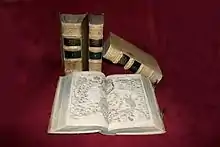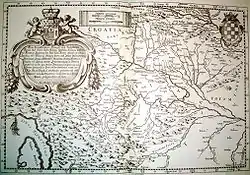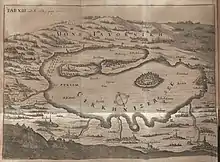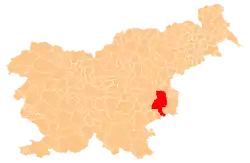Johann Weikhard von Valvasor
Johann Weikhard Freiherr von Valvasor[Note 1] or Johann Weichard Freiherr von Valvasor[Note 2] (Slovene: Janez Vajkard Valvasor, pronounced [ˈʋáːlʋazɔɾ])[2] or simply Valvasor (baptised on 28 May 1641 – September or October 1693) was a natural historian and polymath from Carniola, present-day Slovenia, and a fellow of the Royal Society in London.
Johann Weikhard von Valvasor Janez Vajkard Valvasor | |
|---|---|
 Valvasor in 1689 | |
| Born | 1641 |
| Died | September or October 1693 (aged 52) |
| Known for | nobleman, scholar, polymath |
| Title | Member of the Royal Society |
| Spouse(s) | Anna Rosina Valvasor née Grafenweger |
| Website | http://www.valvasor.org |

.jpg.webp)

He is known as a pioneer of study of karst studies. Together with his other writings, until the late 19th century his best-known work—the 1689 Glory of the Duchy of Carniola, published in 15 books in four volumes—was the main source for older Slovenian history, making him one of the precursors of modern Slovenian historiography.[3]
Biography
Valvasor was born in the town of Ljubljana, then Duchy of Carniola, now the capital of Slovenia. In the 16th century, It was Johann Baptist Valvasor who established the family Valvasor in the Duchy of Carniola in central Europe in a part of Austria that is now the Republic of Slovenia. In medieval Latin "Valvasor" or "Valvasore" held the meaning "the carrier of the feud". In western Europe its use can be traced back to the 11th century.
Neither the exact day nor the actual place of Valvasor's birth are known, but his baptism was registered at Ljubljana Cathedral. He was the twelfth child born to Bartholomäus and Anna Maria Freiin von Rauber, who only lived at Medija Castle in Izlake but also had a town residence in Ljubljana at Old Square. His godparents were Freiherr (Baron) Konrad Ruess von Ruessenstein from Strmol Castle and Regina Dorothea Rasp from Krumperk Castle.
Valvasor's father died when the boy was ten years old. His mother died when he was 16. At the time he was attending the Jesuit school in Ljubljana.[4] Graduating in 1659 at the age of seventeen, he did not choose to continue his studies at a university but decided to broaden his horizons by meeting learned men on a journey across Europe. This journey lasted fourteen years and it even took him to northern Africa. During this period, he joined the army in the Austro-Turkish War, where he became closely acquainted with the conditions on the Croatian Military Frontier.
Shortly after marrying Anna Rosina Grafenweger in 1672, Valvasor acquired Bogenšperk Castle near Litija, where he arranged a writing, drawing and printing workshop. Valvasor spent a fortune on the publishing of his books; towards the end of his life, his debts forced him to sell Bogenšperk Castle, his vast library and his collection of prints. In 1690, Aleksandar Ignacije Mikulić, the Bishop of Zagreb, bought his library, along with some 7,300 graphics, and moved it to Slavonia, where the collection became part of the library of the Zagreb Archbishopric, now part of the Croatian State Archives.[5] Valvasor died in September 1693 in Krško. He is believed to have been buried in the family crypt at Medija Castle,[6] but this is uncertain.[1] The Yugoslav Partisans dynamited the castle in 1944[7] and no trace of his putative grave remains today.[6]
Legacy
The Glory of the Duchy of Carniola
Valvasor's most important work remains The Glory of the Duchy of Carniola (original title: Die Ehre deß Herzogthums Crain,[8][9] Slovene: Slava vojvodine Kranjske), published in 1689[10] in 15 books (four volumes), totalling 3532 pages and including 528 illustrations and 24 appendices, which provides a vivid description of Carniola at the time. He also recorded the first written document on vampires when he wrote on the legend of a vampire in Istria named Jure Grando.[11][12]
From 2009 until 2012, it was translated into Slovene by Doris, Primož and Božidar Debenjak. The initiator, project manager, editor and technical editor of this monumental publishing project was Tomaž Čeč.[13]
Karst research
Valvasor was a pioneer of study of karst phenomena. Upon the proposal of Edmond Halley, who was not only an astronomer but also a geophysicist, and in 1687 his extensive treatise on the hydrology of the intermittent Lake Cerknica won him a Fellowship of the Royal Society.[14]
Works
- Dominicae passionis icones, 1679, reprint 1970 COBISS 261635
- Topographia Ducatus Carnioliae modernae das ist Controfee aller Stätt, Märckht, Clöster und Schlösser, wie sie anietzo stehen in dem Herzogthumb Crain, 1679, reprint 1970 COBISS 19019831
- Topographia arcium Lambergianarum id est arces, castella et dominia in Carniolia habita possident comites a Lamberg; Bagenspergi (Bogenšperg), 1679 COBISS 75121664, reprint 1995 COBISS 50098688
- Topographia Archiducatus Carinthiae modernae: das ist Controfee aller Stätt, Märckht, Clöster, undt Schlösser, wie sie anietzo stehen in dem Ertzhertzogthumb Khärnten; Wagensperg in Crain (Bogenšperg), 1681 COBISS 87695872; Nürnberg, 1688 COBISS 87695872
- Carniolia, Karstia, Histria et Windorum Marchia, Labaci (Ljubljana) 1681 COBISS 217886464
- Theatrum mortis humanae tripartitum: figuris aeneis illustratum : das ist: Schau-Bühne des menschlichen Todts in drey Theil : mit schönen Kupffer-Stichen geziehrt vnd an Tag gegeben; Laybach, Saltzburg (Ljubljana, Salzburg); 1682 COBISS 53622528
- Topographia Archiducatus Carinthiae antiquae & modernae completa: Das ist Vollkommene und gründliche Land – Beschreibung des berühmten Erz – Herzogthums Kärndten; Nürnberg 1688, COBISS 87695872
- Opus insignium armorumque ... ;(1687–1688) COBISS 33650176
- Die Ehre deß Hertzogthums Crain: das ist, Wahre, gründliche, und recht eigendliche Belegen- und Beschaffenheit dieses Römisch-Keyserlichen herrlichen Erblandes; Laybach (Ljubljana) 1689 COBISS 29952257
 Illustration from critique of first volume of Die Ehre deß Hertzogthums Crain published in Acta Eruditorum, 1689
Illustration from critique of first volume of Die Ehre deß Hertzogthums Crain published in Acta Eruditorum, 1689
Notes
- The word "Freiherr" denotes a baron. Valvasor never officially held the title, but was referred to as such by the people who admired him and gradually adopted it also himself in his writings.[1]
- Although the spelling Weichard is used in Die Ehre... and Topographia..., the spelling Weikhard is more common in printed sources today.
References
- Golec, Boris (2007). "Neznano in presenetljivo o življenju, družini, smrti, grobu in zapuščini Janeza Vajkarda Valvasorja" [Hitherto Unknown and Surprising Findings about the Life, Family, Death, Gravesite, and Legacy of Janez Vajkard Valvasor] (PDF). Zgodovinski časopis [Historical review]: Glasilo Zveze zgodovinskih društev Slovenije (in Slovenian, English, and German). 61 (3–4): 303–364. ISSN 0350-5774. COBISS 27721261.
- "Slovenski pravopis 2001". Retrieved 25 March 2015.
- Reisp, Branko et al. (1987): Korespondenca Janeza Vajkarda Valvasorja z Royal Society. Ljubljana: SAZU, p. 15.
- Dolgan, Marjan; Fridl, Jerneja; Volk, Manca (2014). "Janez Vajkard / Johann Weikhard Valvasor". Slovenski književniki v Ljubljani [Slovene Literates in Ljubljana] (in Slovenian). ZRC. p. 215. ISBN 9789612547110.
- Croatian State Archives, Division of the Zagreb Archbishopy. Retrieved 3 April 2009 (in Croatian) Archived 19 October 2008 at the Wayback Machine
- "Valvasor, Janez Vajkard, baron". Slovenski biografski leksikon. Retrieved 15 April 2018.
- Information sign posted at Medija Castle.
- Johann Weichard von Valvasor: Die Ehre Deß Hertzogthums Crain, Das ist, Wahre, gründliche, und recht eigendliche Gelegen- und Beschaffenheit dieses, in manchen alten und neuen Geschicht-Büchern zwar rühmlich berührten, doch bishero nie annoch recht beschriebenen Römisch-Keyserlichen herrlichen Erblandes : Anjetzo, Vermittelst einer vollkommenen und ausführlichen Erzehlung aller seiner Landschafften, Felder ... alter und neuer Denckwürdigkeiten ... Jn Funffzehen, wiewol in vier Haupt-Theile unterschiedenen, Büchern, wie auch häuffigen Abrissen und zierlichen Kupffer-Figuren, ausgebreitet / von Johann Weichard Valvasor, Freyherrn. Aber Jn reines Teutsch gebracht von Erasmum Francisci. Laybach, Anno MDCLXXXIX.
- Ley, Willy (February 1968). "Epitaph for a Lonely Olm". For Your Information. Galaxy Science Fiction. pp. 95–104.
- Die Ehre dess Hertzogthums Crain. Acta Eruditorum. Leipzig. 1689. pp. 549 [i.e. 529].
- Boris Perić, Vampir, Biblioteka 21, Zagreb ( Naklada Ljevak) 2006. (Croat) ISBN 953-178-741-7
- Boris Perić, Vampir, translated into Slovene by Iztok Osojnik, Zbirka Beri globalno, Ljubljana (Tuma) 2007. ISBN 978-961-6682-05-3
- "Veliki podvig prevajanja Valvasorja je zaključen". MMC RTV Slovenija. RTV Slovenija. 6 June 2012.
- Reisp, Branko et al. 1987. Korespondenca Janeza Vajkarda Valvasorja z Royal Society. Ljubljana: SAZU, p. 15.
External links
| Wikimedia Commons has media related to Johann Weikhard von Valvasor. |
